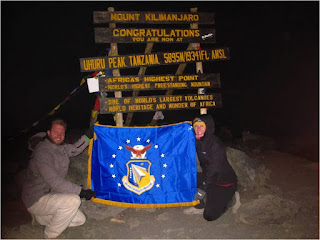At Sea Level
I'm Kevin Schmidt, an Engineering Psychologist at the Air Force Research Laboratory (AFRL), flying the AFRL flag with my colleague, Dr. Molly Fischer, at the summit of Mount Kilimanjaro. At
19,341 feet (5895m) above sea level, I thought about why I and so many others push the limits
of human performance.
Five days of backcountry hiking, three hours of sleep in the
last two days of the ascent, a six hour summit push, and facing potentially -15°Celcius
(5°Farenheit) air temperature
characterized many of the reasons that people would provide as a rationale to
avoid such a challenge. These challenges
enhanced my appreciation for the adaptability of the human experiences as well
as cued a fascination with the process underlying that adaptation. How can humans perform such incredible feats
when altitude alone should tear the mind and body down?
I'm committing myself to the understanding of this process. My next challenge is an attempt to summit Aconcagua (22,841 feet/ 6962m), the tallest
peak in South America. This time, however, my efforts are in the name of science.
The second of my Seven Summits, will take place alongside colleagues Simone
Erchov (Research Solutions Consulting, LLC) and Jake Quartuccio (JQ Scientific,
LLC) in an effort to gather pilot data for research on altitude acclimatization
and the impact of low-oxygen environments on cognition. Our trio chose Aconcagua
for several reasons. First, attempting the summit of Aconcagua via the Normal
Route will not require any technical rock, ice, or glacial traverse techniques.
The Normal Route poses its own challenges, however, and does
not come without risk. Aconcagua typically sees around a 30% summit success
rate annually, primarily due to variable weather conditions, high winds, and
extreme altitude. Climbing over 20,000 feet (6096m) alone poses several
interesting and unique challenges from both a physical and cognitive
perspective. The less technical route offers our team an opportunity to focus
on the more direct impact of altitude acclimatization while controlling for
several potential risks they might otherwise encounter on more technical
routes/mountains.
One thing that our team enjoys as just as much as mountain climbing is mixing our research interests with climbing interests. In the next few blog posts, we will share travel updates and our research ideas about cognition and performance in hostile environments, like mountains.






Comments
Post a Comment